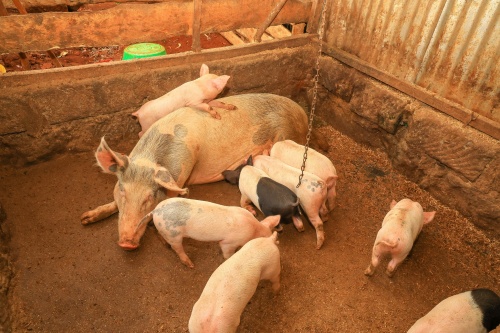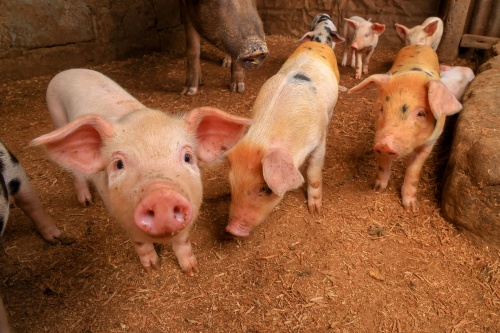In modern swine production, understanding the intricacies of reproductive physiology is not just a matter of academic interest—it’s a key to farm productivity and efficiency. Among the many biological processes that govern reproduction, the formation and ovulation of follicles in sows stand at the very center. For farmers, veterinarians, and reproductive technologists, gaining insights into this process means better estrus synchronization, optimal insemination timing, and improved conception rates.

ในบทความนี้, we explore the biological mechanisms behind follicular development and ovulation in sows, explain how these processes are regulated, and draw comparisons with international perspectives and farm practices to ensure global relevance and clarity. Let’s dive into the life cycle of a follicle, from its invisible beginnings to the dramatic moment of ovulation.
Understanding the Follicular Wave in Sows
Unlike humans, where typically one dominant follicle matures each month, pigs are polyovulatory—meaning multiple follicles develop and ovulate simultaneously. The follicular development in sows is characterized by a process known as follicular waves, a dynamic phenomenon where a cohort of follicles begins to grow, regress, or ovulate depending on hormonal signals.
The sow’s estrous cycle spans around 21 days and includes four phases: proestrus, estrus, metestrus, and diestrus. Follicular development predominantly occurs during proestrus and estrus, under the stimulation of gonadotropins—especially follicle-stimulating hormone (FSH) และ luteinizing hormone (LH).
At the beginning of the follicular wave, primordial follicles, which are dormant within the ovaries since birth, begin to activate. These grow into primary and then secondary follicles, forming multiple layers of granulosa cells and developing a fluid-filled cavity called the antrum, becoming antral follicles.
Hormonal Regulation of Follicular Growth
Follicular development is tightly regulated by the hypothalamic-pituitary-gonadal (HPG) axis. Here’s how the key hormones interact:
-
GnRH (Gonadotropin-releasing hormone) from the hypothalamus stimulates the anterior pituitary to release FSH และ LH.
-
FSH promotes the recruitment and growth of small antral follicles.
-
LH supports the maturation of dominant follicles and triggers ovulation.
As follicles grow, they produce increasing amounts of estradiol, a form of estrogen. When estradiol levels reach a certain threshold, they initiate a positive feedback loop that triggers a surge in LH secretion—this LH surge is what finally induces ovulation.
Internationally, researchers emphasize the importance of timing in managing sow reproduction. As reported in studies from the University of Saskatchewan and Wageningen University, the variability in follicular growth rates between gilts (young sows) and multiparous sows (older sows) makes it critical to monitor hormone profiles and follicle size when timing insemination.
Follicular Maturation and Selection in Sows
As antral follicles develop, they enter a competitive phase. Not all follicles survive; only a subset reaches dominant follicle status. These dominant follicles grow more rapidly, have higher vascularization, and become increasingly responsive to LH.
In sows, around 15–25 follicles may be recruited during the follicular phase, but only those with sufficient LH receptor expression and estradiol synthesis will mature to ovulation. This selection process is crucial for:
-
Determining litter size
-
Ensuring oocyte quality
-
Minimizing cystic follicle development
International practitioners often use ultrasonography (i.e., non-invasive ultrasound) to monitor follicular growth. In Europe and North America, B-mode ultrasound scanning is frequently used to measure follicle diameter, typically observing diameters ranging from 4 mm in early antral follicles to over 7 mm just before ovulation. Research from Iowa State University suggests that follicles reaching 6–8 mm in diameter within 36 hours prior to ovulation are usually the most fertile.

The Moment of Ovulation
Ovulation in sows usually occurs 36–44 hours after the onset of standing estrus. The LH surge initiates a cascade of cellular events, รวมถึง:
-
Breakdown of the follicular wall
-
Release of proteolytic enzymes
-
Expansion of the cumulus-oocyte complex
Each follicle releases its oocyte (egg cell) into the oviduct, where it may be fertilized if viable sperm is present. Unlike cows, where ovulation occurs from a single follicle, sows typically ovulate 15–20 follicles, ensuring a large litter size—an economically significant trait for pig producers worldwide.
Interestingly, studies from Denmark’s Aarhus University show that environmental factors like ambient temperature and feed energy levels can affect ovulation timing and follicle quality. Heat stress, for example, delays follicular development and reduces ovulation efficiency—a concern for farms in tropical and subtropical regions.
Follicular Dysfunction and Practical Challenges
Despite the natural efficiency of sow reproduction, certain dysfunctions can impair fertility:
-
Follicular cysts: When follicles grow but fail to ovulate, they may persist as cysts, interfering with subsequent cycles.
-
Silent ovulation: Ovulation occurs without behavioral estrus, complicating insemination timing.
-
Delayed ovulation: If insemination occurs too early, fertilization may fail due to oocyte aging.
Western veterinary literature emphasizes the importance of precise monitoring tools. เช่น, ultrasonography with real-time image guidance has allowed U.S. and Canadian swine farms to better synchronize artificial insemination (AI), especially when coupled with hormonal protocols like PG600 or eCG injections to stimulate follicular development.
New Insights from Ultrasonography
In recent years, veterinary ultrasound has played an increasingly central role in reproductive management. In countries like Germany, Spain, and Brazil, swine veterinarians now rely on portable ultrasound scanners to monitor follicle development directly on the farm.
These scanners help identify:
-
Follicle count and size
-
Pre-ovulatory readiness
-
Signs of cystic degeneration
Research published in the journal Theriogenology shows that when sows are monitored by ultrasound every 12 hours during estrus, the precision of insemination timing increases conception rates by up to 15%.
Moreover, ultrasonography has proven valuable in selecting gilts for breeding—those with consistently fewer developing follicles may be culled earlier, improving overall herd fertility.
Nutritional and Genetic Influence
Genetics and nutrition significantly influence follicle dynamics. เช่น:
-
Genetic lines bred for higher litter sizes often show earlier and more robust follicular development.
-
High-energy diets with sufficient protein boost follicle growth and enhance oocyte viability.
-
Zinc, selenium, and vitamins A/E play a role in regulating oxidative stress within growing follicles, promoting healthier ovulation.
In several American and European trials, high-performing gilts fed optimized transition diets showed more synchronized and predictable ovulations. The implication is clear: precision feeding and genetics go hand in hand with reproductive monitoring to maximize productivity.
บทสรุป
Understanding the process of follicular development and ovulation in sows is fundamental for successful reproduction management. From hormonal regulation to the impact of environment, nutrition, and genetics, each element plays a critical role in determining the reproductive outcome.
With the integration of ultrasonography—especially portable, real-time imaging—producers can now observe these internal processes as never before. This technological advancement has bridged the gap between theoretical reproductive physiology and real-world decision-making on swine farms.
By applying insights from international research and embracing tools like ultrasound, producers worldwide can expect more accurate insemination timing, higher conception rates, and ultimately, better economic returns.
Reference Sources:
-
Soede, N. M., & Kemp, B. (2020). “Follicular development and ovulation in the sow.” Theriogenology, 150, 270–275. https://doi.org/10.1016/j.theriogenology.2020.01.015
-
Knox, R. V. (2016). “The anatomy and physiology of the sow reproductive system.” Veterinary Clinics of North America: Food Animal Practice, 32(2), 145–164. https://www.sciencedirect.com/science/article/abs/pii/S0749072016000191
-
Guthrie, H. D., & Edwards, J. L. (2021). “Ovarian follicular dynamics and fertility in pigs.” Journal of Animal Science, 99(2), skab011. https://academic.oup.com/jas/article/99/2/skab011/6158292
-
Iowa State University Extension. (2023). “Swine Reproduction: Practical Use of Ultrasound.” https://www.extension.iastate.edu/
-
Aarhus University. (2022). “Environmental Effects on Sow Reproduction.” https://anis.au.dk/en/research/production-and-health/swine-reproduction